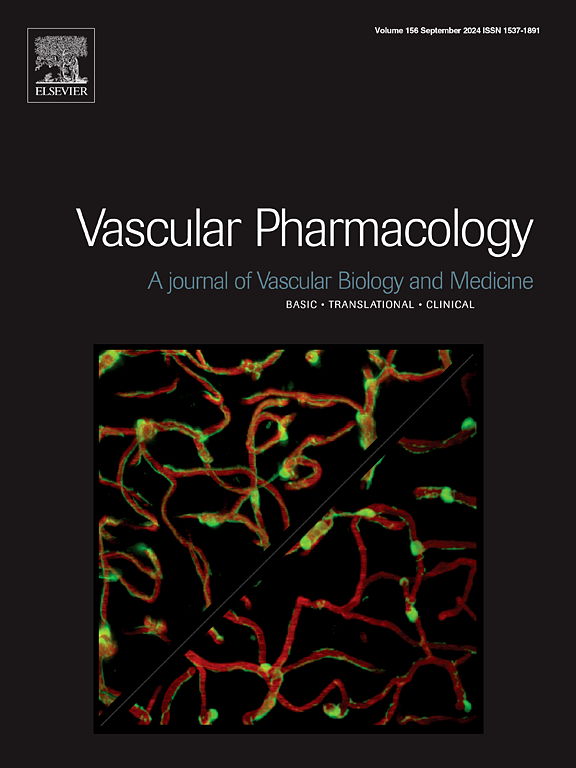在代谢综合征和心力衰竭的大型动物模型中,钠-葡萄糖共转运蛋白2抑制通过内皮信号恢复睾丸微血管灌注
IF 3.5
3区 医学
Q2 PHARMACOLOGY & PHARMACY
引用次数: 0
摘要
目的研究钠-葡萄糖共转运蛋白2 (SGLT2)抑制对猪代谢综合征(MetS)和缺血性心肌病(ICM)模型睾丸微血管功能和血管信号通路的影响。方法用高脂饲粮诱导2只公约克郡猪发生代谢转移。11周时,在左旋动脉周围放置一个ameroid缩窄器诱导ICM。经过两周的稳定期后,将猪随机分为高脂肪对照组(HFC)和卡格列净组(HCAN, 300 mg/天),为期五周。末梢采集评估睾丸灌注、内皮功能标志物和促凋亡信号。结果scanag列净(CAN)显著改善睾丸灌注(p = 0.0134)。分子分析显示,p-AMPK/AMPK比值显著升高(p = 0.0483),表明代谢和内皮信号传导增强,BAD/BCL2比值显著降低(p = 0.0095),与向抗凋亡信号传导的转变一致。p-eNOS/eNOS比值在处理动物中呈上升趋势(p = 0.1007),提示一氧化氮介导的血管舒张可能增强。ERK总表达量也增加(p = 0.0201),支持MAPK通路的参与。结论sglt2抑制可改善睾丸微血管灌注,调节关键信号比率,包括p-AMPK/AMPK升高、BAD/BCL2降低,并有升高p-eNOS/eNOS的趋势。这些发现表明,卡格列净促进外周组织的血管存活途径,强调其血管保护潜力超出心肌。本文章由计算机程序翻译,如有差异,请以英文原文为准。

Sodium-glucose cotransporter 2 inhibition restores testicular microvascular perfusion via endothelial signaling in a large animal model of metabolic syndrome and heart failure
Objective
This study evaluates the effects of sodium-glucose cotransporter 2 (SGLT2) inhibition on testicular microvascular function and vascular signaling pathways in a swine model of metabolic syndrome (MetS) and ischemic cardiomyopathy (ICM).
Methods
Eleven male Yorkshire swine were fed a high-fat diet to induce MetS. At 11 weeks, ICM was induced by placing an ameroid constrictor around the left circumflex artery. After a two-week stabilization period, swine were randomized into a high-fat control (HFC) or canagliflozin-treated (HCAN, 300 mg/day) group for five weeks. Terminal harvests were performed to assess testicular perfusion, endothelial function markers, and pro-apoptotic signaling.
Results
Canagliflozin (CAN) significantly improved testicular perfusion (p = 0.0134). Molecular analysis showed a significant increase in p-AMPK/AMPK ratio (p = 0.0483), indicating enhanced metabolic and endothelial signaling, and a significant reduction in BAD/BCL2 ratio (p = 0.0095), consistent with a shift toward anti-apoptotic signaling. The p-eNOS/eNOS ratio trended upward in treated animals (p = 0.1007), suggesting potential augmentation of nitric oxide–mediated vasodilation. Total ERK expression was also increased (p = 0.0201), supporting engagement of MAPK pathways.
Conclusion
SGLT2 inhibition improved testicular microvascular perfusion and modulated key signaling ratios, including increased p-AMPK/AMPK and reduced BAD/BCL2, with a trend toward higher p-eNOS/eNOS. These findings demonstrate that canagliflozin promotes vascular survival pathways in peripheral tissues, underscoring its vasculoprotective potential beyond the myocardium.
求助全文
通过发布文献求助,成功后即可免费获取论文全文。
去求助
来源期刊

Vascular pharmacology
医学-药学
CiteScore
6.60
自引率
2.50%
发文量
153
审稿时长
31 days
期刊介绍:
Vascular Pharmacology publishes papers, which contains results of all aspects of biology and pharmacology of the vascular system.
Papers are encouraged in basic, translational and clinical aspects of Vascular Biology and Pharmacology, utilizing approaches ranging from molecular biology to integrative physiology. All papers are in English.
The Journal publishes review articles which include vascular aspects of thrombosis, inflammation, cell signalling, atherosclerosis, and lipid metabolism.
 求助内容:
求助内容: 应助结果提醒方式:
应助结果提醒方式:


